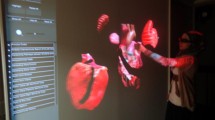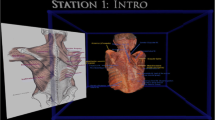Abstract
Over the last decade, the use of computerized three-dimensional (3D) models in a virtual environment has become widespread to enhance medical teaching and learning, particularly in anatomy. Technologies such as Virtual Reality (VR) offer large potential to enhance medical training processes.
The research focus of this paper is to investigate the effectiveness of using predesigned off-the-shelf VR software to teach medical knowledge in comparison with a conventional teaching method. Also investigated was the degree of satisfaction associated with using VR to learn. The teaching example focuses on the anatomy of the human heart because it is one of the most challenging topics to teach and comprehend due to its complex three-dimensional nature.
A randomized controlled study was conducted with forty participants. They were equally distributed into two groups: 20 in control (non-VR) and 20 in experimental (VR) group. Two learning methods were used to study the heart. The non-VR group used PowerPoint presentation, whereas the VR group used immersive VR from off-the-shelf software.
This study subsequently gives insight on three main aspects: First, there was significant difference in anatomy knowledge within the two groups. Second, the VR group found the learning experience to be significantly more engaging, enjoyable, and useful. Third, non-customizable predesigned software can be suitable and effective for medical training tasks and applications.
Access this chapter
Tax calculation will be finalised at checkout
Purchases are for personal use only
Similar content being viewed by others
References
Cooper, J., Taqueti, V.: A brief history of the development of mannequin simulators for clinical education and training. Postgrad. Med. J. 84(997), 563–570 (2008)
Falah, J., Charissis, V., Khan, S., Chan, W., Alfalah, S.F.M., Harrison, D.K.: Development and evaluation of virtual reality medical training system for anatomy education. In: Arai, K., Kapoor, S., Bhatia, R. (eds.) Intelligent Systems in Science and Information 2014. SCI, vol. 591, pp. 369–383. Springer, Cham (2015). https://doi.org/10.1007/978-3-319-14654-6_23
HealthySimulation.com. Virtual anatomy \(|\) healthcare simulation \(|\) healthysimulation.com (2021). https://www.healthysimulation.com/virtual-anatomy/
Kavanagh, S., Luxton-Reilly, A., Wuensche, B., Plimmer, B.: A systematic review of virtual reality in education. Themes Sci. Technol. Educ. 10(2), 85–119 (2017)
Maresky, H., Oikonomou, A., Ali, I., Ditkofsky, N., Pakkal, M., Ballyk, B.: Virtual reality and cardiac anatomy: exploring immersive three-dimensional cardiac imaging, a pilot study in undergraduate medical anatomy education. Clin. Anat. 32(2), 238–243 (2019)
McLachlan, J.C., Patten, D.: Anatomy teaching: ghosts of the past, present and future. Med. Educ. 40(3), 243–253 (2006)
Nicholson, D.T., Chalk, C., Funnell, W.R.J., Daniel, S.J.: Can virtual reality improve anatomy education? a randomised controlled study of a computer-generated three-dimensional anatomical ear model. Med. Educ. 40(11), 1081–1087 (2006)
Petersson, H., Sinkvist, D., Wang, C., Smedby, Ö.: Web-based interactive 3d visualization as a tool for improved anatomy learning. Anatom. Sci. Educ. 2(2), 61–68 (2009)
Pixo. Off-the-shelf XR solutions for every organization (2021). https://pixovr.com/off-the-shelf-xr-solutions/
Privett, B., Greenlee, E., Rogers, G., Oetting, T.A.: Construct validity of a surgical simulator as a valid model for capsulorhexis training. J. Cataract Refract. Surg. 36(11), 1835–1838 (2010)
Sajid, A., et al.: Cardiology patient simulator and computer-assisted instruction technologies in bedside teaching. Med. Educ. 24(6), 512–517 (1990)
Sharecare Inc. Sharecare YOU (2021). https://www.sharecareyou.com/
Stepan, K., et al.: Immersive virtual reality as a teaching tool for neuroanatomy. Int. Forum Allergy Rhinol. 7, 1006–1013 (2017)
Sugand, K., Abrahams, P., Khurana, A.: The anatomy of anatomy: a review for its modernization. Anatom. Sci. Educ. 3(2), 83–93 (2010)
Varjo Technologies Oy. System requirements - varjo.com (2021). https://varjo.com/use-center/get-started/system-requirements/#hardware
Wainman, B., Wolak, L., Pukas, G., Zheng, E., Norman, G.R.: The superiority of three-dimensional physical models to two-dimensional computer presentations in anatomy learning. Med. Educ. 52(11), 1138–1146 (2018)
Xiaoying, L., Xianbo, S.: The application of virtual reality technology in teaching reform. In: Advanced Technology in Teaching, pp. 149–156. Springer, Heidelberg (2012). https://doi.org/10.1007/978-3-642-29458-7_24
Yammine, K., Violato, C.: The effectiveness of physical models in teaching anatomy: a meta-analysis of comparative studies. Adv. Health Sci. Educ. 21(4), 883–895 (2015). https://doi.org/10.1007/s10459-015-9644-7
Zhao, J., Xu, X., Jiang, H., Ding, Y.: The effectiveness of virtual reality-based technology on anatomy teaching: a meta-analysis of randomized controlled studies. BMC Med. Educ. 20(1), 1–10 (2020)
Zinchenko, Y., Khoroshikh, P., Sergievich, A., Smirnov, A., Tumyalis, A., Kovalev, A., Gutnikov, S., Golokhvast, K.: Virtual reality is more efficient in learning human heart anatomy especially for subjects with low baseline knowledge. New Ideas Psychol. 59, 100786 (2020)
Acknowledgement
We thank Dr. med. C. Schadow from St. Marienstift hospital (Magdeburg, Germany) for the great support with our project, especially with compilation of the non-VR teaching material.
Author information
Authors and Affiliations
Corresponding author
Editor information
Editors and Affiliations
Ethics declarations
Conflict of Interest Statement
The software and hardware used in this study was purchased at the regular price. The authors have no connection to Varjo or Sharecare, Inc. The results presented here are based on the sole actions of the authors and are in no way related to Sharecare, Inc or Varjo.
Rights and permissions
Copyright information
© 2022 The Author(s), under exclusive license to Springer Nature Switzerland AG
About this paper
Cite this paper
Odame, A., Tümler, J. (2022). Is Off-the-Shelf VR Software Ready for Medical Teaching?. In: Chen, J.Y.C., Fragomeni, G. (eds) Virtual, Augmented and Mixed Reality: Design and Development. HCII 2022. Lecture Notes in Computer Science, vol 13317. Springer, Cham. https://doi.org/10.1007/978-3-031-05939-1_15
Download citation
DOI: https://doi.org/10.1007/978-3-031-05939-1_15
Published:
Publisher Name: Springer, Cham
Print ISBN: 978-3-031-05938-4
Online ISBN: 978-3-031-05939-1
eBook Packages: Computer ScienceComputer Science (R0)




